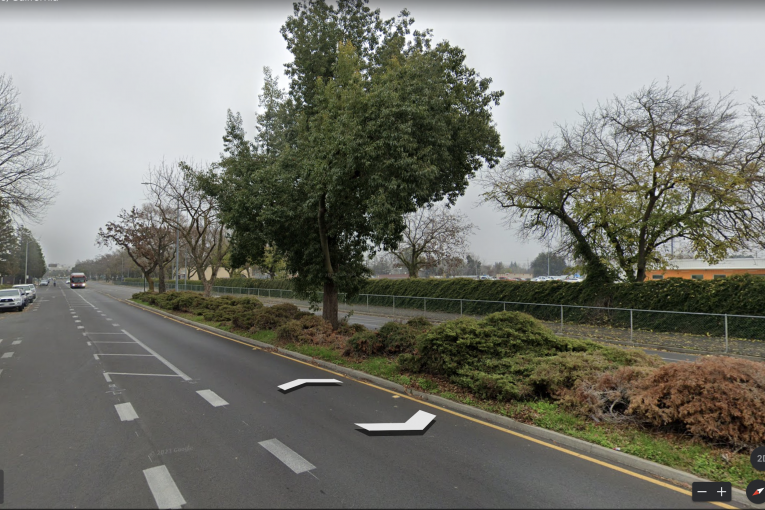
February 2, 2023
This evening the city staff provided a Zoom overview of some conceptual reconfigurations for the section of 5th Street between L St. to the west and Cantrill Dr. (past Pole Line) to the east.
Google earth image:
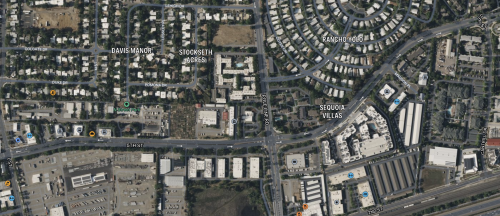
It should be noted that there is no budget item for this project. So it is, you might say, very much in the preliminary stages.
You can see the plans
here.
5th St. had auto lanes reduced from two to one lane over a year ago, with restriping for the bike lanes. This created the Buffered Bike lanes:
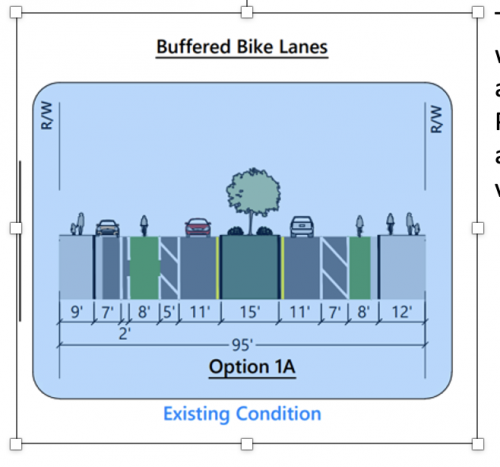
The other options show Separated Bikeways, one-way or two-way, even some with landscaping added along the roadway.

Personally, I really had to stare at this schematic for a while before I understood it, and found it easier to visualize it as I look at it each day.
Presently on the north side (i.e., in front of my nursery, looking toward the PG&E yard) it goes: sidewalk, parking/loading, bike lane, traffic, center planter.
It appears that the Separated Bikeway model goes:
sidewalk, bike lane, parking/loading, traffic, center planter.
And then the deluxe model adds a layer of landscaping with trees in it just off the sidewalk (note: I’m all for this idea).
On the face of it, it seems to me that off-loading trucks and having active parking on the traffic side of the bike lane, requiring traversing the bike traffic, is less safe. But I could be wrong about that. Or maybe it makes it safer for bicyclists and the proportional benefits outweigh this concern. I would be interested to hear from someone who knows about that sort of thing.
I just feel the need to remind people that in our little commercial zone there on the west end of 5th, goods are received by rather large trucks, and many of the goods being moved in and out are rather bulky. Trees and bags of compost, and cars arriving in various stages of distress with flat tires and broken engines, things like that.
Two of our neighbors and I met a few days ago to discuss shared concerns.
• It’s important to retain street parking.
• Left turn into the existing businesses could be safer and more efficient (assuming the center planter is being removed, as shown in a couple of the options illustrated).
• Pedestrian crosswalk east of the DMA building would be useful.
• Legal U-turn should be provided mid-block.
• Need to plan for large truck deliveries to existing businesses.
We also agree that the lane reduction has worked well.
Some interesting comments from the meeting participants.
John Sleuter of Rancho Yolo (who also serves on the tree commission but was speaking for himself) spoke on behalf of the trees. More from me on that below.
Interesting perspective from a pedestrian who walks the route regularly. The east end is a pleasure. She doesn’t like the sidewalks on the north side at the west end; they’re irregular and seem dangerous.
Consensus is that the strangely fenced-in bike/walkway along the south side needs to be opened up. As in, right away.
More than one comment about the intersections both needing work; another noted the lack of safety along the PG&E corner (we learned that PG&E is going to be replacing that whole fence!).
It was noted that the city yard and whole area has been mentioned for redevelopment.
I didn’t comment at the meeting but will make these points now.
• To the last point, first: there has been discussion about redeveloping the 5th St. corridor since the economic development plan (remember that?) that came forth about 2009 or so. All the rest of that plan has collapsed, and I see little likelihood of commercial redevelopment there any time soon. Too many overlapping jurisdictions, moving parts, and institutional inertia. If anything, it’s all coveted for housing someday. But none of that really needs to delay making this road and especially its intersections safer.
• The sidewalk all down the north side of 5th street should be widened and harmonized for pedestrian and some bike access. It should be pleasant, leafy and shaded as you walk all down that street; it’s always had a surprising amount of foot traffic.
A little history: when we built in 1980, we were required to put in the sidewalk as you see it there, narrowing down from 4’ to 3’ as you go. Terrible egress pretty much everywhere down the street. That whole area seemed unplanned from the start. It wasn’t even really clear what the zoning was (I made sure to get our zoning permit first thing). Nobody even knew then why there was a caged bike lane on the south side. And it all just went down to the edge of a field and stopped at the post office; the Pole Line overpass wasn’t there yet. It got grafted on later in a rather unsatisfactory manner.
Fortunately, it’s a very wide street (why?), so the fact that people regularly walk or bike diagonally across traffic wasn’t that dangerous for many years. But there’s now a big increase in bike traffic that needs to be managed.
This stretch of roadway and the adjoining corporation yards is low on trees, and you can see the result on summer surface temperatures:
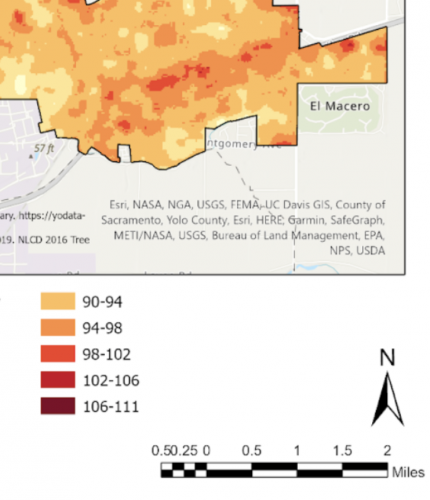
The key to reducing urban heat island effect is shading asphalt.
• For the health and cooling benefits to the neighborhood, there should be a specific goal of shading at least 50% of the asphalt in that whole area: the broad roadway, the corporation yards, and especially all the sidewalks. If PG&E is really there to stay, they owe it to the whole community to plant trees, or solar panels, or both over much of their open corporation yard.
• Several large trees could be planted in planters down the middle of 5th St.
• Medium-size trees could be in new roadside planters where space is available.
• The transit hubs could be improved, to put it mildly. Basic principle of tree planning: put the trees where people are to get the greatest health and cooling benefits.
This is very much a work in progress and your input is actually welcome.
Kudos to Ryan Chapman (P.E., T.E., Assistant Director of Public Works – Engineering and Transportation, rchapman@cityofdavis.org) for a very efficient presentation.
Project page here.
Project area here.
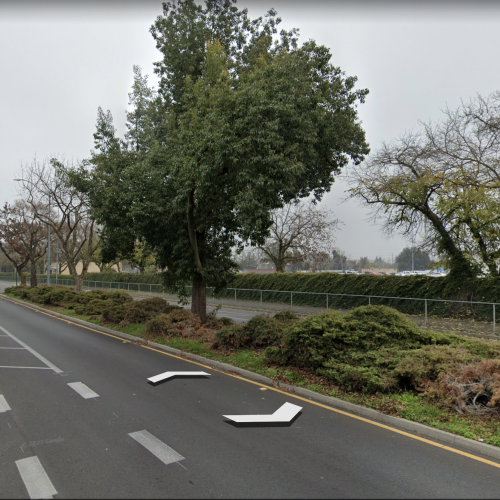



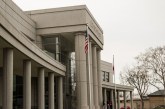
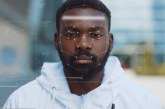
More urban trees could prevent heat-related deaths: study
https://www.smartcitiesdive.com/news/urban-trees-prevent-heat-deaths-green-infrastructure-study/641839/
The urban heat island effect can harm city residents’ cardiovascular and respiratory health, particularly in lower-income neighborhoods, and lead to premature deaths in some cases. Adding more trees as cooling agents to the urban environment could prevent some of those deaths, according to findings from a modeling study published this week in The Lancet, a global research journal.
Researchers conducted a health impact assessment looking at data from 93 European cities during the summer of 2015, per a research summary. They found that one-third of the premature deaths attributed to higher temperatures that summer could have been prevented by increasing urban tree cover to 30%, but average tree cover in European cities stands at about half of that at 14.9%.
The authors say it’s the first study looking at how increased tree cover could prevent premature deaths. “Our ultimate goal is to inform local policy and decision-makers about the benefits of strategically integrating green infrastructure into urban planning to promote more sustainable, resilient and healthy urban environments and contribute to climate change adaptation and mitigation,” said lead author Tamar Iungman in a press release.
https://www.thelancet.com/journals/lancet/article/PIIS0140-6736(22)02585-5/fulltext